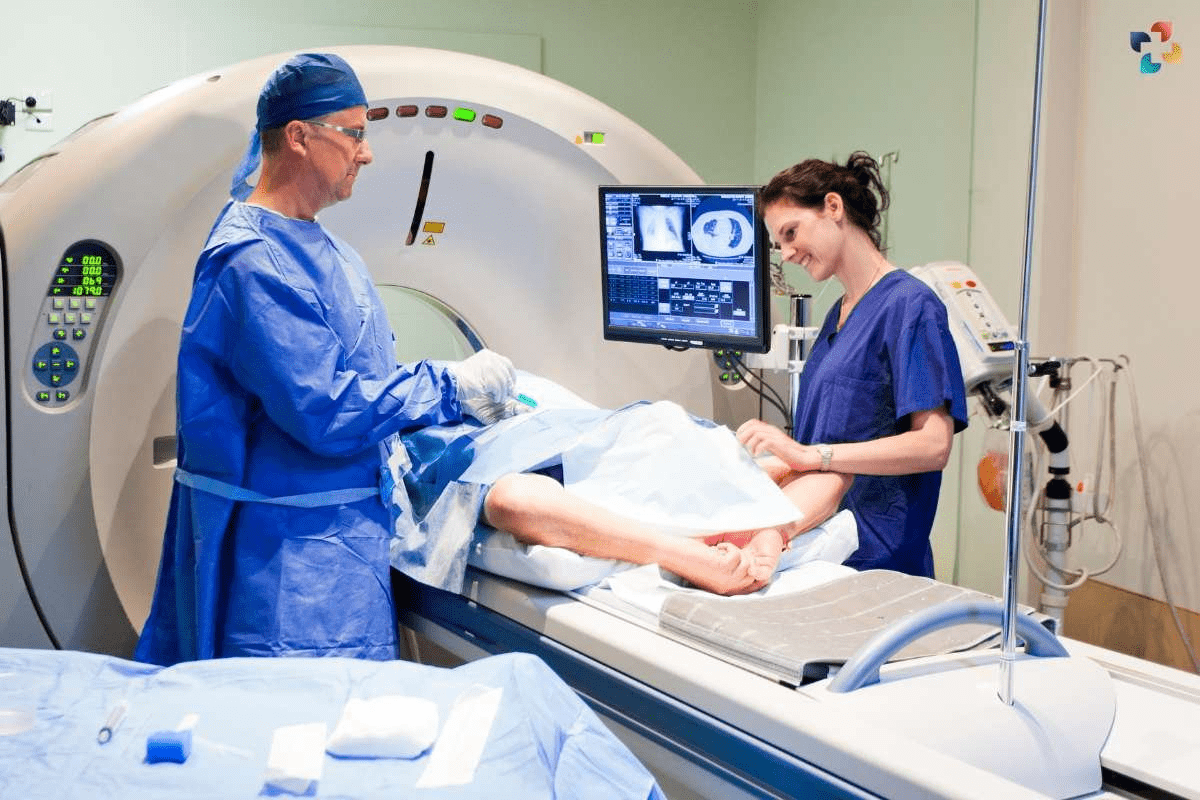Last Updated on November 26, 2025 by Bilal Hasdemir

Ovarian cancer is often called a “silent disease” because its symptoms are vague. 1 in 78 women will be diagnosed with ovarian cancer in their lifetime. It’s important to find reliable early indicators.
Knowing the risk factors and finding ovarian cancer early can greatly improve treatment. Medical research has led to new tests, including biomarker tests.
Key Takeaways
- Ovarian cancer is a significant health risk for women, with a substantial impact on their lives.
- Early detection is key for effective treatment and better survival rates.
- Finding reliable indicators is essential for diagnosing ovarian cancer early.
- Biomarker tests are promising for detecting ovarian cancer.
- Understanding risk factors can help prevent and detect ovarian cancer early.
Understanding Ovarian Cancer: A Silent Disease
Ovarian cancer is often called a “silent disease.” It’s a complex condition that needs a deep understanding for effective management. This cancer starts in the ovaries, which are part of the female reproductive system. Its various types and subtle symptoms make early detection hard.
Definition and Types of Ovarian Cancer

Ovarian cancer is a malignant tumor in the ovaries. It has several types, based on where it starts. The most common is epithelial ovarian cancer, from the outer ovary layer. Germ cell and stromal tumors are less common but important.
Knowing the type of ovarian cancer is key for treatment. Epithelial ovarian cancer is the most common, making up about 90% of cases. Germ cell tumors and stromal tumors need different treatments because of their unique characteristics.
| Type of Ovarian Cancer | Description | Prevalence |
| Epithelial Ovarian Cancer | Arises from the outer layer of the ovary | About 90% |
| Germ Cell Tumors | Originates from the cells that produce eggs | About 5% |
| Stromal Tumors | Develops in the connective tissue of the ovary | About 1% |
Why Early Detection is Crucial for Survival
Finding ovarian cancer early greatly improves survival chances. Early diagnosis leads to better treatment outcomes. But, ovarian cancer’s “silent” nature often means it’s diagnosed too late.
Survival rates for ovarian cancer depend on when it’s found. The American Cancer Society says the 5-year survival rate is about 49% for all stages. But, if caught at stage I, the rate jumps to around 90%, showing why early detection is so vital.
It’s important to understand ovarian cancer, its types, and the need for early detection. Recognizing symptoms early and getting medical help can greatly improve survival chances.
The Challenge of Detecting Ovarian Cancer Early
Ovarian cancer is hard to catch early because it’s silent in its first stages. It often grows to a more serious stage before symptoms show up. This makes it hard to treat on time.
Why Ovarian Cancer is Often Diagnosed Late
Many things make it hard to catch ovarian cancer early. Non-specific symptoms like bloating and pain in the belly can be mistaken for other things. There’s no good test for ovarian cancer that works for everyone.
This means many cases are found too late. Advanced-stage diagnosis makes treatment harder and changes the outlook for patients.
Survival Rates by Stage of Diagnosis
How long you live with ovarian cancer depends on when it’s found. If caught early (Stage 1), the chances of living five years are much better.
- Stage 1: About 90% five-year survival rate
- Stage III or IV: Survival rates drop to around 20-30%
Knowing these numbers shows how key it is to find cancer early. We need better ways to diagnose it.
Ovarian Cancer Early Indicators: Recognizing the Warning Signs

It’s important to know the early signs of ovarian cancer to get medical help quickly. Ovarian cancer is called a “silent disease” because its symptoms are often vague and similar to other health issues.
Common Symptoms That Shouldn’t Be Ignored
While ovarian cancer symptoms can be vague, there are key signs to watch for. These include:
- Abdominal bloating or swelling
- Pelvic pain or pressure
- Difficulty eating or feeling full quickly
- Urinary urgency or frequency
- Unexplained weight loss
These symptoms can last a long time and get worse. It’s key to notice any changes in your body. If you have any of these signs, see a doctor right away.
When Symptoms Warrant Immediate Medical Attention
If you have severe symptoms, get medical help fast:
- Severe pelvic pain
- Difficulty breathing
- Vaginal bleeding
- Severe bloating or abdominal pain
These symptoms can mean different things, but a doctor can help figure out what’s going on.
Ovarian Cancer Symptom Checklist:
| Symptom | Description | Action |
| Abdominal Bloating | Feeling of swelling or tightness in the abdomen | Monitor and consult a doctor if persistent |
| Pelvic Pain | Pain or discomfort in the pelvic region | Seek medical attention if severe or persistent |
| Urinary Urgency | Frequent need to urinate | Consult a healthcare provider if accompanied by other symptoms |
Knowing the early signs of ovarian cancer and when to see a doctor can greatly improve treatment and survival chances.
Abdominal and Pelvic Symptoms as Possible Signs
It’s important to know the signs of ovarian cancer in the abdomen and pelvis. These symptoms can be early warnings. They might seem like other, less serious issues at first.
Bloating and Increased Abdominal Size
Many people with ovarian cancer notice abdominal bloating and a bigger belly. This feeling of tightness or swelling doesn’t go away. The Cleveland Clinic says these signs are linked to ovarian cancer and should be checked out.
- Bloating that lasts a long time
- Abdomen that looks bigger
- Pain or discomfort in the belly
Pelvic Pain and Pressure
Pelvic pain and pressure are also signs of ovarian cancer. This pain can be steady or come and go. It might feel like your pelvis is heavy or under pressure. If the pain doesn’t go away or is really bad, see a doctor.
- Pelvic pain that doesn’t get better
- Feeling of pressure or heaviness in the pelvis
- Discomfort when sitting or exercising
Knowing these symptoms can help find ovarian cancer early. If you have ongoing or bad symptoms, talk to a doctor right away.
Gastrointestinal Symptoms That May Signal Ovarian Cancer
Gastrointestinal issues can be an early warning sign of ovarian cancer. This cancer is often called a “silent killer” because its symptoms are vague. Yet, some gastrointestinal symptoms can hint at the disease.
Feeling Full Quickly and Loss of Appetite
Feeling full quickly after eating is a symptom of ovarian cancer. This happens when a tumor presses on the stomach or affects digestion nerves. Loss of appetite often follows, leading to weight loss and malnutrition.
A study in the Journal of Clinical Oncology found many ovarian cancer patients felt full quickly. This symptom, while not specific, is important to watch for with other signs.
Changes in Bowel Habits
Changes in bowel habits, like constipation or diarrhea, can signal ovarian cancer. These changes might come from the tumor’s pressure or the body’s reaction to cancer. It’s key to see a doctor if these changes last.
| Symptom | Possible Cause | Action |
| Feeling full quickly | Tumor pressing against the stomach | Consult a doctor if persistent |
| Loss of appetite | Affects nerves controlling digestion | Seek medical evaluation |
| Changes in bowel habits | Tumor’s pressure on the bowel | Discuss with a healthcare provider |
Dr. [Last Name] from the American Cancer Society says, “It’s vital to recognize ovarian cancer symptoms early.” Knowing these gastrointestinal symptoms can help catch the disease sooner. This could lead to better treatment outcomes.
“The key to improving ovarian cancer survival rates lies in early detection. Recognizing the subtle symptoms, including gastrointestinal changes, is vital.”
- An Oncologist
Urinary Symptoms and Other Physical Changes
Certain urinary and physical changes might suggest ovarian cancer. These signs can be subtle and often point to other conditions. This makes finding the right diagnosis tricky.
Frequent Urination and Urinary Urgency
Frequent need to urinate and urgency can hint at ovarian cancer. This is true if a tumor is near the bladder or ureters. These urinary symptoms can really disrupt your day. They might also be signs of other, less serious issues.
But if these symptoms don’t go away or get worse, see a doctor. They can help figure out what’s causing them.
- Frequent need to urinate
- Urgency to urinate
- Potential impact on quality of life
Fatigue, Unexplained Weight Loss, and Back Pain
Fatigue is a common symptom in many cancers, including ovarian cancer. It can make you feel extremely tired. This is because your body is fighting the tumor or because of anemia.
Unexplained weight loss can also happen. Ovarian cancer can mess with your metabolism and appetite. Back pain, if it lasts a long time and has no clear cause, might also be a sign of ovarian cancer. This is true if the cancer has spread to the pelvic or abdominal areas.
It’s important to remember that these symptoms don’t always mean you have ovarian cancer. But if they keep happening or come with other symptoms, you should get checked by a doctor.
- Fatigue as a possible symptom
- Unexplained weight loss
- Back pain as a possible indicator
A study found that women with ovarian cancer often have symptoms like pelvic pain, abdominal bloating, and urinary issues.
This mix of symptoms should lead to further investigation.
Blood Tests for Ovarian Cancer Detection
Finding ovarian cancer early is key, and blood tests play a big role. They can spot certain markers in the blood that might show ovarian cancer is present.
CA-125 Blood Test: Benefits and Limitations
The CA-125 blood test is often used to find ovarian cancer. It checks the CA-125 protein in the blood, which can be high in women with ovarian cancer. The CA-125 test is good for tracking how well treatment is working and spotting when cancer comes back. But, it has downsides like a high rate of false positives and can’t find all ovarian cancers.
Some issues with the CA-125 blood test are:
- It can lead to false positives, causing worry and extra tests
- It misses some ovarian cancers, mainly the early ones
- Other conditions like endometriosis or pregnancy can also raise CA-125 levels
Emerging Biomarkers and Multi-Marker Tests
Scientists are looking into new biomarkers and multi-marker tests to fix the CA-125 test’s problems. These new tests aim to find ovarian cancer more accurately and maybe even earlier.
Some exciting research areas include:
- HE4, a protein that’s been found to be high in ovarian cancer
- Multi-marker tests that mix CA-125 with other biomarkers to boost detection
- Genetic tests to find women with BRCA1 and BRCA2 mutations, who are at higher risk
Creating better blood tests for ovarian cancer is a big focus of research. As new biomarkers and tests come along, they promise to help find cancer sooner and save lives.
Imaging Studies Used in Ovarian Cancer Diagnosis
Many imaging studies help diagnose ovarian cancer accurately. These tools are key for finding cancer, seeing how far it has spread, and planning treatment.
Transvaginal Ultrasound as a Primary Screening Tool
Transvaginal ultrasound is a first step in finding ovarian cancer. It uses a probe in the vagina to see the ovaries clearly. This method is great for spotting cysts or tumors in the ovaries. The pelvic ultrasound for ovarian cancer gives detailed images for early detection.
CT Scans and MRI for Detailed Assessment
When cancer is suspected, CT scans and MRI are used for a closer look. CT scans show the abdomen and pelvis in cross-section. They help find the tumor’s size and if it has spread. MRI gives detailed views of soft tissues, helping to understand ovarian masses and their danger. Both mri and ct scans ovarian cancer detection are vital for disease staging and treatment planning.
PET Scans and Their Role in Staging
PET scans are also important in ovarian cancer diagnosis and management. They use a radioactive sugar that cancer cells take up. This helps see tumors and check if treatment is working. PET scans of ovarian cancer staging show how far cancer has spread. This is key for choosing the best treatment.
Genetic Risk Factors as Indicators for Screening
Knowing about genetic risk factors helps find people at higher risk for ovarian cancer. This knowledge leads to better screening. Genes and family history are key in figuring out ovarian cancer risk.
BRCA1 and BRCA2 Mutations
BRCA1 and BRCA2 gene mutations raise ovarian cancer risk a lot. Women with a BRCA1 mutation face a 35% to 70% chance of getting ovarian cancer. Those with a BRCA2 mutation have a 10% to 30% risk. Genetic testing for BRCA mutations is suggested for those with breast and ovarian cancer in their family.
Finding BRCA mutations helps understand ovarian cancer risk. It also guides decisions on preventive surgeries. Knowing your BRCA status can lead to early detection and better survival chances.
Lynch Syndrome and Family History Considerations
Lynch syndrome, caused by DNA mismatch repair gene mutations, raises cancer risk, including ovarian cancer. People with Lynch syndrome face a 3% to 14% chance of ovarian cancer. Family history is key in assessing Lynch syndrome risk.
| Genetic Condition | Ovarian Cancer Risk | Recommended Screening |
| BRCA1 Mutation | 35%-70% | Genetic testing, annual screening |
| BRCA2 Mutation | 10%-30% | Genetic testing, annual screening |
| Lynch Syndrome | 3%-14% | Genetic testing, consideration of prophylactic surgery |
It’s important to know your genetic risk and family history for ovarian cancer screening. Healthcare providers can help choose the right screening based on your risk.
The Role of Gynecological Exams in Detection
Gynecological exams are key in finding ovarian cancer early. They are a big part of women’s health care. They help doctors check the health of the reproductive organs.
During a routine gynecological exam, doctors do a pelvic examination. They look for any oddities in the reproductive organs. This includes checking the ovaries’ size, shape, and feel.
What Doctors Look For During Pelvic Exams
Doctors look for signs of ovarian cancer or other health issues during a pelvic exam. They check for:
- Abnormalities in the size or shape of the ovaries
- Presence of masses or tumors
- Any unusual tenderness or pain
Limitations of Physical Examination for Ovarian Masses
Pelvic exams are important but have their limits in finding ovarian masses. Several things can affect how well a physical exam can find ovarian cancer. These include:
- The size and location of the ovarian mass
- The patient’s body type and overall health
- The skill and experience of the healthcare provider performing the exam
To understand the limits and strengths of pelvic exams in finding ovarian cancer, let’s look at some data:
| Detection Method | Effectiveness in Detecting Ovarian Cancer | Limitations |
| Pelvic Exam | Can detect large masses or significant abnormalities | Limited by size and location of the mass, patient’s body type |
| Imaging Tests (e.g., Ultrasound) | More sensitive for detecting smaller masses and abnormalities | May not distinguish between benign and malignant masses |
| Blood Tests (e.g., CA-125) | Can indicate possible ovarian cancer through elevated markers | Not specific to ovarian cancer; can be elevated in other conditions |
It’s clear that while gynecological exams are vital, a complete approach with many detection methods is needed for effective ovarian cancer diagnosis.
Combining Multiple Detection Methods for Better Results
Early detection of ovarian cancer can be greatly improved by using different diagnostic methods. This multi-faceted approach helps doctors find the disease early. This leads to better treatment outcomes.
Risk Assessment Tools are key in this combined strategy. The Risk of Ovarian Cancer Algorithm (ROCA) is one such tool.
Risk of Ovarian Cancer Algorithm (ROCA)
The ROCA is a complex algorithm that looks at a woman’s risk of ovarian cancer. It uses CA-125 blood test results over time. ROCA spots patterns that may show a higher risk of ovarian cancer, even with normal test results.
Benefits of ROCA include finding ovarian cancer early. This can lead to better survival rates. Research shows ROCA boosts detection in high-risk women.
Symptom Indices and Risk Assessment Tools
ROCA is not the only tool. Symptom indices and other risk assessment tools are also being developed. These tools look at symptoms and risk factors to guess the chance of ovarian cancer.
Symptom indices focus on common symptoms like bloating, pelvic pain, and trouble eating. They help doctors spot women at higher risk. This means more women can get checked out.
Using ROCA with symptom indices and other tools is a promising way to find ovarian cancer early. This approach helps doctors catch the disease when it’s easier to treat.
High-Risk Groups: When Enhanced Surveillance is Needed
Some women are at higher risk for ovarian cancer and need closer watch. Knowing these risks helps find cancer early and manage it better.
Age and Menopausal Status as Risk Factors
Age is a big risk factor for ovarian cancer, with most cases in women over 50. The risk goes up even more after menopause. It’s important for women to know how their age affects their risk.
Risk by Age Group:
| Age Group | Relative Risk |
| Under 40 | Low |
| 40-49 | Moderate |
| 50-59 | High |
| 60+ | Very High |
Personal Medical History Factors
Your medical history can also raise your risk for ovarian cancer. Having had breast cancer, or carrying BRCA1 and BRCA2 genes, increases your risk. Other factors like never having children or trouble getting pregnant also matter.
Lifestyle and Environmental Risk Factors
Lifestyle and environmental factors also play a part in ovarian cancer risk. Some can be changed, but others can’t. Knowing these can help figure out your risk.
Important lifestyle and environmental risks include being overweight, smoking, and exposure to harmful chemicals. Knowing these can help you assess your risk and maybe take steps to prevent it.
Conclusion: The Future of Ovarian Cancer Detection
The future of finding ovarian cancer early is all about better detection methods and knowing the risks. We’re using blood tests, imaging, and genetic tests to find it sooner. These steps together could really help us catch it early.
More research is needed to save lives. Finding cancer early means we can start treatment sooner. This could lead to better results. New biomarkers and tests are big steps towards this goal.
We must also spread the word about ovarian cancer signs and risks. Teaching people and doctors can help catch it sooner. With ongoing research, the outlook for ovarian cancer detection is looking up.
FAQ
What are the best tests for ovarian cancer detection?
The top tests for finding ovarian cancer are the CA-125 blood test and transvaginal ultrasound. CT scans, MRI, and PET scans are also used. Researchers are looking into new biomarkers and tests to find cancer early.
What are the early warning signs of ovarian cancer?
Signs of ovarian cancer early on include bloating and feeling full quickly. You might also notice pelvic pain, loss of appetite, and changes in bowel habits. Other signs are frequent urination, fatigue, unexplained weight loss, and back pain.
How accurate is the CA-125 blood test as an ovarian cancer marker?
The CA-125 blood test is not perfect for finding ovarian cancer. It can be high in many cases, though. It’s good for tracking treatment and finding cancer again. But, it can give false positives and misses early-stage cancer.
What is the role of pelvic ultrasound in ovarian cancer detection?
Pelvic ultrasound, like transvaginal ultrasound, is a key tool for finding ovarian cancer. It lets doctors see the ovaries and spot problems like cysts or tumors.
How do MRI and CT scans contribute to ovarian cancer detection?
MRI and CT scans help doctors see more details and how far cancer has spread. They check if cancer has touched nearby areas.
What are the indicators of stage 1 ovarian cancer?
Stage 1 ovarian cancer signs are often mild. You might feel bloated, have pelvic pain, or notice bowel changes. Finding it early can greatly improve your chances of survival.
How does family history impact ovarian cancer risk?
Family history is a big risk factor for ovarian cancer. If you have a family history of breast or ovarian cancer, you’re at higher risk. Genetic mutations like BRCA1 and BRCA2 also increase your risk.
What is the significance of genetic testing for BRCA mutation in ovarian cancer?
Testing for BRCA1 and BRCA2 mutations can show if you’re at higher risk for ovarian cancer. Knowing this can help you make choices about screening and prevention.
What are the silent symptoms of ovarian cancer?
Silent symptoms of ovarian cancer are not always obvious. They might include mild stomach discomfort, bowel changes, or feeling tired. These symptoms can be easy to overlook.
How do gynecological exams aid in ovarian cancer detection?
Gynecological exams can help find ovarian cancer by spotting abnormalities. Yet, they can miss early signs, mainly in women with a larger body mass index.
What are the high-risk indicators for ovarian cancer?
High-risk factors for ovarian cancer include age and family history. Being postmenopausal, having a history of certain conditions, and genetic mutations like BRCA1 and BRCA2 also increase your risk.
References
- Medina, J. E., et al. (2025). Early Detection of Ovarian Cancer Using Cell-Free DNA Fragmentomes and Protein Biomarkers. Cancer Discovery. https://pubmed.ncbi.nlm.nih.gov/39345137/






